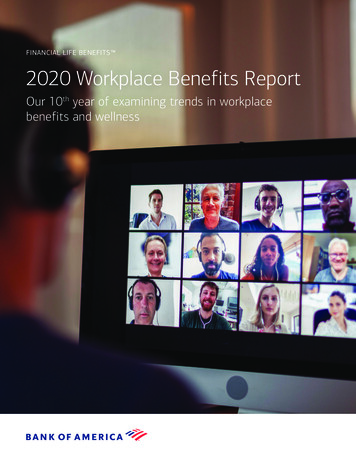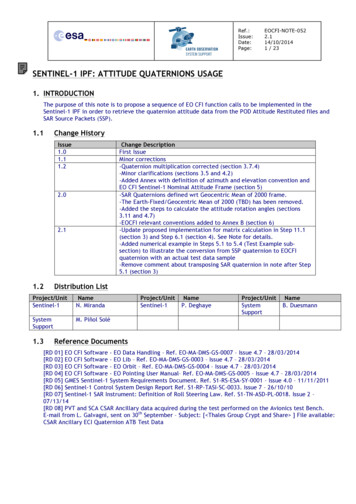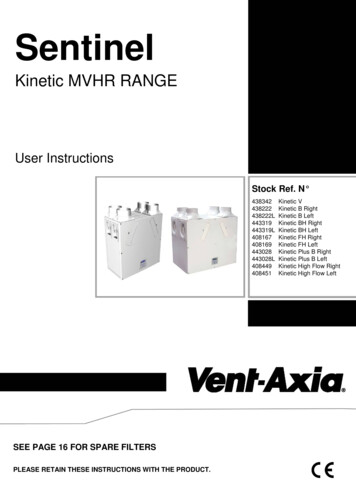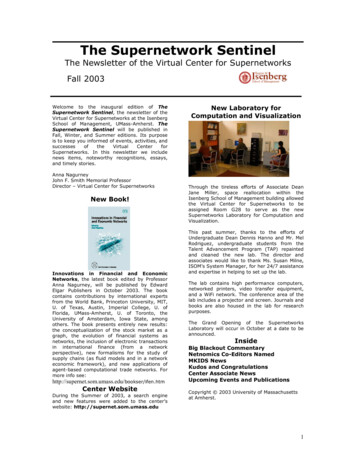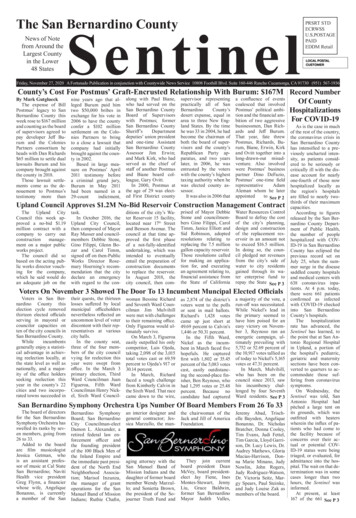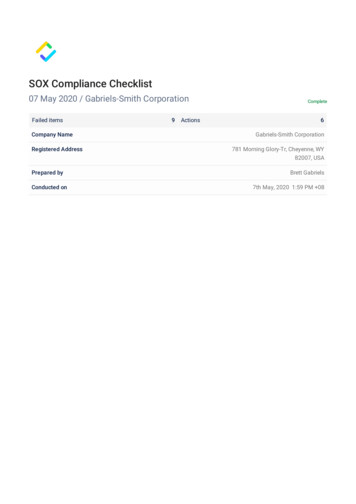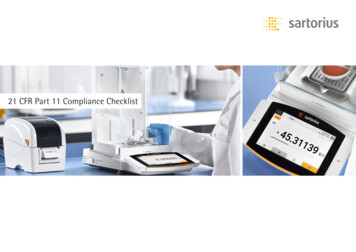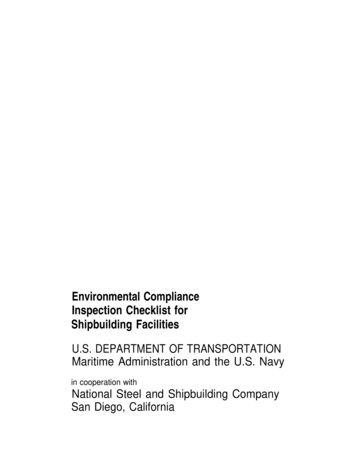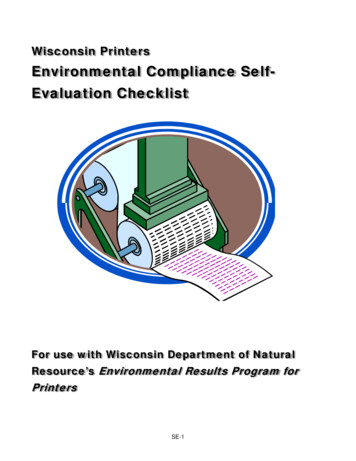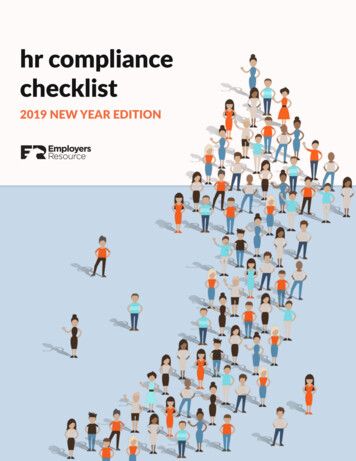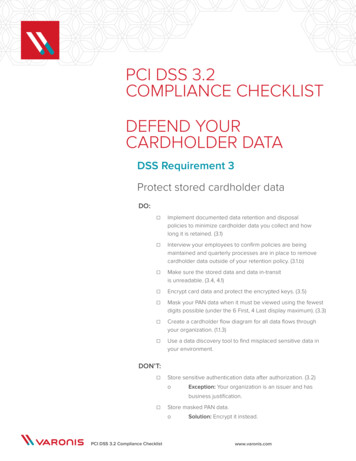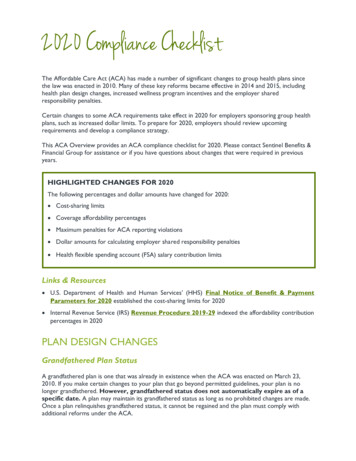
Transcription
2020 Compliance ChecklistThe Affordable Care Act (ACA) has made a number of significant changes to group health plans sincethe law was enacted in 2010. Many of these key reforms became effective in 2014 and 2015, includinghealth plan design changes, increased wellness program incentives and the employer sharedresponsibility penalties.Certain changes to some ACA requirements take effect in 2020 for employers sponsoring group healthplans, such as increased dollar limits. To prepare for 2020, employers should review upcomingrequirements and develop a compliance strategy.This ACA Overview provides an ACA compliance checklist for 2020. Please contact Sentinel Benefits &Financial Group for assistance or if you have questions about changes that were required in previousyears.HIGHLIGHTED CHANGES FOR 2020The following percentages and dollar amounts have changed for 2020: Cost-sharing limits Coverage affordability percentages Maximum penalties for ACA reporting violations Dollar amounts for calculating employer shared responsibility penalties Health flexible spending account (FSA) salary contribution limitsLinks & Resources U.S. Department of Health and Human Services’ (HHS) Final Notice of Benefit & PaymentParameters for 2020 established the cost-sharing limits for 2020 Internal Revenue Service (IRS) Revenue Procedure 2019-29 indexed the affordability contributionpercentages in 2020PLAN DESIGN CHANGESGrandfathered Plan StatusA grandfathered plan is one that was already in existence when the ACA was enacted on March 23,2010. If you make certain changes to your plan that go beyond permitted guidelines, your plan is nolonger grandfathered. However, grandfathered status does not automatically expire as of aspecific date. A plan may maintain its grandfathered status as long as no prohibited changes are made.Once a plan relinquishes grandfathered status, it cannot be regained and the plan must comply withadditional reforms under the ACA.
Contact Sentinel Benefits & Financial Group if you have questions about changes you have made, or areconsidering making, to your plan.Review your plan’s grandfathered status: If you have a grandfathered plan, determine whether it will maintain its grandfathered statusfor the 2020 plan year. Grandfathered plans are exempt from some of the ACA’s mandates. Agrandfathered plan’s status will affect its compliance obligations from year to year.If your plan will lose its grandfathered status for 2020, confirm that the plan has all of theadditional patient rights and benefits required by the ACA for non-grandfathered plans. Thisincludes, for example, coverage of preventive care without cost-sharing requirements.If your plan will keep its grandfathered status, continue to provide the Notice ofGrandfathered Status in any plan materials provided to participants and beneficiaries thatdescribe the benefits provided under the plan (such as the plan’s summary plan descriptionand open enrollment materials). Model language is available. Cost-Sharing LimitsEffective for plan years beginning on or after Jan. 1, 2014, non-grandfathered health plans are subject tolimits on cost sharing for essential health benefits (EHB). The ACA’s overall annual limit on cost sharing(also known as an out-of-pocket maximum) applies for all non-grandfathered group health plans,whether insured or self-insured. Under the ACA, a health plan’s out-of-pocket maximum for EHB maynot exceed 8,150 for self-only coverage and 16,300 for family coverage, effective for plan yearsbeginning on or after Jan. 1, 2020.Health plans with more than one service provider may divide the out-of-pocket maximum acrossmultiple categories of benefits, rather than reconciling claims across multiple service providers. Thus,health plans and issuers may structure a benefit design using separate out-of-pocket maximums for EHB,provided that the combined amount does not exceed the annual out-of-pocket maximum limit for thatyear. For example, in 2020, a health plan’s self-only coverage may have an out-of-pocket maximum of 6,000 for major medical coverage and 2,150 for pharmaceutical coverage, for a combined out-ofpocket maximum of 8,150.Beginning with the 2016 plan year, the self-only annual limit on cost sharing applies to eachindividual, regardless of whether the individual is enrolled in self-only coverage or familycoverage. This embeds an individual out-of-pocket maximum in family coverage so that an individual’scost sharing for essential health benefits cannot exceed the ACA’s out-of-pocket maximum for self-onlycoverage.Note that the ACA’s cost-sharing limit is higher than the out-of-pocket maximum for high deductiblehealth plans (HDHPs). In order for a health plan to qualify as an HDHP, the plan must comply with thelower out-of-pocket maximum limit for HDHPs. HHS provided FAQ guidance on how this ACA ruleaffects HDHPs with family deductibles that are higher than the ACA’s cost-sharing limit for self-onlycoverage.According to HHS, an HDHP that has a 10,000 family deductible must apply the annual limitation oncost sharing for self-only coverage ( 8,150 in 2020) to each individual in the plan, even if this amount isbelow the 10,000 family deductible limit. Because the 8,150 self-only maximum limitation on costsharing exceeds the 2020 minimum annual deductible amount for HDHPs ( 2,800), it will not cause aplan to fail to satisfy the requirements for a family HDHP.
Review your plan’s cost-sharing limits: Review your plan’s out-of-pocket maximum to make sure it complies with the ACA’s limitsfor the 2020 plan year ( 8,150 for self-only coverage and 16,300 for family coverage).If you have an HSA-compatible HDHP, keep in mind that your plan’s out-of-pocketmaximum must be lower than the ACA’s limit. For 2020, the out-of-pocket maximum limitfor HDHPs is 6,900 for self-only coverage and 13,800 for family coverage.If your plan uses multiple service providers to administer benefits, confirm that the plan willcoordinate all claims for EHBs across the plan’s service providers, or will divide the out-ofpocket maximum across the categories of benefits, with a combined limit that does notexceed the maximum for 2020.Confirm that the plan applies the self-only maximum to each individual in the plan, regardlessof whether the individual is enrolled in self-only coverage or family coverage.Health FSA ContributionsFor plan years beginning on or after Jan. 1, 2013, an employee’s annual pre-tax salary reductioncontributions to a health FSA must be limited to 2,500 (as adjusted). The 2,500 limit was increased to: 2,550 for 2015 and 2016; 2,650 for 2018; and 2,600 for 2017; 2,700 for 2019.On Nov. 6, 2019, the IRS released Revenue Procedure 2019-44, which increased the FSA dollar limit onemployee salary reduction contributions to 2,750 for taxable years beginning in 2020.The limit does not apply to non-elective employer contributions to the health FSA (such as matchingcontributions or flex credits), though employer contributions that employees may elect to receive incash or as a taxable benefit will count toward the limit. Other ACA requirements may impact or limitthe total amount that may be contributed to a health FSA, but non-elective employer contributionsgenerally do not reduce the health FSA limit for the employee. Additionally, the health FSA limit doesnot impact contributions under other employer-provided coverage. For example, employee salaryreduction contributions to an FSA for dependent care or adoption care assistance are not affected bythe health FSA limit.Update your health FSA’s contribution limit: Confirm that your health FSA will not allow employees to make pre-tax contributions inexcess of 2,750 for the 2020 plan year.Communicate the health FSA limit to employees as part of the open enrollment process.SUMMARY OF BENEFITS AND COVERAGE (SBC)Health plans and health insurance issuers must provide an SBC to applicants and enrollees to help themunderstand their coverage and make coverage decisions. Plans and issuers must provide the SBC toparticipants and beneficiaries who enroll or re-enroll during an open enrollment period, as well as toparticipants and beneficiaries who enroll other than through an open enrollment period (includingindividuals who are newly eligible for coverage and special enrollees).
The SBC must follow strict formatting requirements. The Departments provided templates and relatedmaterials, including instructions and a uniform glossary of coverage terms, for use by plans and issuers.The Departments provide a template and related materials for the SBC.Provide the appropriate SBC template: For self-funded plans, the plan administrator is responsible for creating and providing theSBC. For insured plans, the issuer is required to provide the SBC to the plan sponsor. Boththe plan and the issuer are obligated to provide the SBC, although this obligation is satisfiedfor both parties if either one provides the SBC. If you have an insured plan, confirm whetheryour health insurance issuer will assume responsibility for providing the SBCs. HIPAA CERTIFICATIONThe ACA includes a requirement for health plans to file a statement with HHS certifying theircompliance with the Health Insurance Portability and Accountability Act’s (HIPAA) electronictransaction standards and operating rules. These HIPAA requirements are often referred to as theelectronic data interchange (EDI) rules.However, on Oct. 4, 2017, HHS withdrew its proposed rule in order to re-examine the issues andexplore options and alternatives to comply with the HIPAA certification requirement. As a result,group health plan sponsors will not be required to certify their HIPAA compliance untilHHS issues new guidance.Although health plans are not required to certify their HIPAA compliance at this time, there is anenforcement process in place for the EDI rules. Civil monetary penalties and criminal penalties maybe imposed on a covered entity that fails to comply with the EDI rules. Thus, health plans and businessassociates that conduct standard transactions should confirm that they are complying with the EDI rules.Analyze your obligations for the HIPAA certification: Confirm whether your health plan is complying with any applicable EDI rules.Work with your advisors to monitor whether HHS issues any additional guidance on theHIPAA certification requirement. EMPLOYER SHARED RESPONSIBILITY RULESUnder the ACA’s employer shared responsibility rules, applicable large employers (ALEs) are requiredto offer affordable, minimum value (MV) health coverage to their full-time employees (and dependentchildren) or pay a penalty. These employer shared responsibility requirements are also known as the“employer mandate” or “pay or play” rules.An ALE will be subject to penalties if one or more full-time employees receive a subsidy for purchasinghealth coverage through an Exchange. An individual may be eligible for an Exchange subsidy eitherbecause the ALE: Does not offer coverage to that individual; or Offers coverage that is “unaffordable” or does not provide “minimum value.”
This checklist will help you evaluate your possible liability for an employer shared responsibility penaltyfor 2020. Please keep in mind that this summary is a high-level overview of the employer shared responsibilityrules. It does not provide an in-depth analysis of how the rules will affect your organization. Please contactSentinel Benefits & Financial Group for more information on these rules and how they may apply to you.Applicable Large Employer StatusThe ACA’s employer shared responsibility rules apply only to ALEs. ALEs are employers with 50 ormore full-time employees (including full-time equivalent employees, or FTEs) on business days during thepreceding calendar year. Employers determine each year, based on their current number of employees,whether they will be considered an ALE for the following year.Determine your ALE status for 2020: Calculate the number of full-time employees for each calendar month in 2019. A full-timeemployee is an employee who is employed, on average, at least 30 hours of service perweek or 130 hours for the calendar month.Calculate the number of FTEs for each calendar month in 2019 by calculating the aggregatenumber of hours of service (but not more than 120 hours for any employee) for allemployees who were not full-time employees for that month and dividing the total hours ofservice by 120.Add the number of full-time employees and FTEs (including fractions) calculated above foreach month in 2019. Add up these monthly numbers and divide the sum by 12. Disregardfractions.If your result is 50 or more, you are likely an ALE for 2020.Keep in mind that there is a special exception for employers with seasonal workers. If yourworkforce exceeds 50 full-time employees (including FTEs) for 120 days or fewer during the2019 calendar year, and the employees in excess of 50 who were employed during that timewere seasonal workers, you will not be an ALE for 2020.Companies under common ownership may have to be combined to determine their ALEstatus.Offering Coverage to Full-time EmployeesTo correctly offer coverage to full-time employees, ALEs must determine which employees are full-timeemployees under the employer shared responsibility rule definition. A full-time employee is an employeewho was employed, on average, at least 30 hours of service per week (or 130 hours of service ina calendar month).The IRS provided two methods for determining full-time employee status for purposes of offeringcoverage—the monthly measurement method and the look-back measurement method.Involves a month-to-month analysis where full-time employees are identifiedbased on their hours of service for each month. This method is not based onMONTHLYaveraging hours of service over a prior measurement method. Month-to-monthMEASUREMENTmeasuring may cause practical difficulties for employers that have employeesMETHODwith varying hours or employment schedules, and could result in employeesmoving in and out of employer coverage on a monthly basis.
An optional safe harbor method for determining full-time status that canprovide greater predictability for determining full-time status. The details of thismethod are based on whether the employees are ongoing or new, and whethernew employees are expected to work full time or are variable, seasonal or parttime.LOOK-BACKThis method involves a measurement period for counting hours of service,MEASUREMENT an administrative period that allows time for enrollment and disenrollment,METHODand a stability period when coverage may need to be provided, depending onan employee’s average hours of service during the measurement period.If an employer meets the requirements of the safe harbor, it will notbe liable for penalties for employees who work full time during thestability period, if they did not work full-time hours during themeasurement period.Determine your full-time employees: Use the monthly measurement method or the look-back measurement method to confirmthat health coverage will be offered to all full-time employees (and dependent children). Ifyou have employees with varying hours, the look-back measurement method may be thebest fit for you.To use the look-back measurement method, you will need to select your measurement,administrative and stability periods. Please contact Sentinel Benefits & Financial Group formoreApplicable PenaltiesAn ALE is only liable for a penalty under the employer shared responsibility rules if at least one full-timeemployee receives a subsidy for coverage purchased through an Exchange. Employees who are offeredhealth coverage that is affordable and provides MV are generally not eligible for these Exchange subsidies.Depending on the circumstances, one of two penalties may apply under the employer shared responsibilityrules—the 4980H(a) penalty or the 4980H(b) penalty.The 4980H(a) Penalty—Penalty for ALEs not Offering CoverageUnder Section 4980H(a), an ALE will be subject to a penalty if it does not offer coverage to “substantiallyall” full-time employees (and dependents) and any one of its full-time employees receives a premium taxcredit or cost-sharing reduction toward his or her Exchange plan. The 4980H(a) penalty will not apply toan ALE that intends to offer coverage to all of its full-time employees, but that fails to offer coverage to afew of these employees, regardless of whether the failure to offer coverage was inadvertent.An ALE will satisfy the requirement to offer minimum essential coverage to “substantially all” of its fulltime employees and their dependents if it offers coverage to at least 95%—or fails to offer coverage tono more than 5% (or, if greater, five)—of its full-time employees (and dependents). According to the IRS,the alternative margin of five full-time employees is designed to accommodate relatively small ALEs,because a failure to offer coverage to a handful of full-time employees might exceed 5% of the ALE’s fulltime employees.
Under the ACA, the monthly penalty assessed on ALEs that do not offer coverage to substantially all fulltime employees and their dependents is equal to the ALE’s number of full-time employees (minus30) X 1/12 of 2,000 (as adjusted), for any applicable month. After 2014, the 2,000 amount isindexed for the calendar year, as follows: 2,080 for 2015 2,160 for 2016 2,260 for 2017 2,320 for 2018 2,500 for 2019 2,570 for 2020The 4980H(b) Penalty—Penalty for ALEs Offering CoverageALEs that do offer coverage to substantially all full-time employees (and dependents) may still be subjectto penalties if at least one full-time employee obtains a subsidy through an Exchange because: The ALE did not offer coverage to all full-time employees; or The ALE’s coverage is unaffordable or does not provide minimum value.The monthly penalty assessed on an ALE for each full-time employee who receives a subsidy is 1/12 of 3,000 (as adjusted) for any applicable month. However, the total penalty for an ALE is limited tothe 4980H(a) penalty amount. After 2014, the 3,000 amount is indexed as follows: 3,120 for 2015 3,240 for 2016 3,390 for 2017 3,480 for 2018 3,750 for 2019 3,860 for 2020Affordability of CoverageUnder the ACA, an ALE’s health coverage is considered affordable if the employee’s required contributionto the plan does not exceed 9.5% of the employee’s household income for the taxable year (as adjustedeach year). The adjusted percentage is 9.78% for 2020.“Household income” means the modified adjusted gross income of the employee and any members of theemployee’s family. Because an employer generally will not know an employee’s household income, the IRSprovided three affordability safe harbors that ALEs may use to determine affordability based oninformation that is available to them. These safe harbors allow an ALE to measure affordability based onthe employee’s Form W-2 wages, the employee’s rate of pay or the federal poverty level for asingle individual. ALEs using an affordability safe harbor may rely on the adjusted affordability contributionpercentages.Minimum ValueUnder the ACA, a plan provides MV if the plan’s share of total allowed costs of benefits provided underthe plan is at least 60% of those costs. Three approaches may be used for determining MV: a MinimumValue (MV) Calculator, design-based safe harbor checklists or actuarial certification. Inaddition, any plan in the small group market that meets any of the “metal levels” of coverage (that is,bronze, silver, gold or platinum) provides MV.In addition, plans that do not provide inpatient hospitalization or physician services (referred to as nonhospital/non-physician services plans) do not provide MV. An employer may not use the MV Calculator(or any actuarial certification or valuation) to demonstrate that a non-hospital/non-physician services planprovides MV. As a result, a non-hospital/non-physician services plan should not be adopted forthe 2015
2020 Compliance Checklist The Affordable Care Act (ACA) has made a number of significant changes to group health plans since the law was enacted in 2010. Many of these key reforms became effective in 2014 and 2015, including health plan design changes, increased wellness program inc
